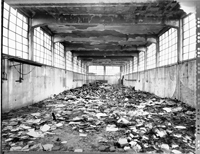Testo di Silvia Paoli
Ex Fabrica. Identità e mutamenti ai confini della metropoli, Silvana Editoriale, 2006
italian below

Cathedrals
Giampietro Agostini carried out his photographic research in 2002 (returninig in 2006) in the industrial areas to the north of Milan, between Sesto S. Giovanni, Pero and the Bovisa zone. The Falck and Magneti Marelli factories and the refineries of Pero are empty "skeletons" in his images, desolate and deserted constructions recalling for us (by metonymy) the historical reality of the factory (fabrica, meaning a building or place for doing things, but also the activity of the faber), a place with a "strong" identity, a place whose relational and symbolic dynamics can found a culture. The preponderant use of viewpoints with a central perspective places what remains of the industrial architecture in the middle the image. Just as in early photographic visions the view isolated the monument, underlining its centrality as a witness to a historical-artistic past with a unique and definite identity, so Agostini places the factory at the centre, underlining its centrality as a witness to a past it which it was a load-bearing structure ot the economy. He re-proposes the majesty and the grandeur of the structures as outposts and bulwarks of the modern city, rich in over a century of history, in contrast with the mutations of the post-modern city, in continious evolution but still lacking a definite identity and physiognomy.
The images are distinguished by continual cross-references, through allusions, between past and present. The solitude of the places, deliberately empty of human presences, evokes forcefully, even in their absence, their historical - but also their present - identity.
The buildings were all photographed in winter, like "dead" bodies. The light is diffused, soft; at times it "explodes" in the interiors (as in the opening photograph), flooding the decaying structures. Interior shots prevail: the photographer is "inside" the body of the building, he rarely views it from outside. He does not indulge in easy aesthetic solutions. He interprets the "historical" places critically and consciously, working only in black and white and often underlining the "materiality" of photographic "actions" (the positive prints let us see the edge of the film ...). He often speaks in symbols and metaphors. An empty building with hundreds of paper documents lying on the ground, probably part of a factory filing system. An image of damnatio memoriae, of a negated past. Silent buildings: at times remains of vegetation (dead leaves ...) appear on the walls, on the round, invading the structures, a metaphor of concealment, even visual, and of oblivion.
The most emblematic image is certainly that of an empty couch on a heap of earth, a trace of human passage; and in the background, on the wall, the American flag. The dignified symbols of an unlived life, one merely dreamed through symbols, and of the city's inability to recognize dignity and rights.
Cattedrali
Giampietro Agostini svolge la sua ricerca fotografica nel 2002 (ritornando nel 2006) nelle aree industriali a nord di Milano, tra Sesto San Giovanni, Pero e il quartiere della Bovisa. Le industrie Falck, la Magneti Marelli e le raffineria di Pero sono nelle sue immagini "scheletri" vuoti, architetture desolata e deserte che rimandano (per metonimia) alla realtà storica della fabbrica (fabrica come edificio e luogo del fare, ma anche come attività del faber), luogo di identità determinate, di dinamiche relazionali e simboliche fondative di una cultura. Agostini adotta con consapevolezza codici espressivi "classici". L'uso preponderante nelle inquadrature della prospettiva centrale colloca al centro, nell'immagine, quello che resta dell'architettura industriale. Così come nella visione fotografica dei primordi la veduta isolava il monumento, sottolineandone la centralità come testimonianze di un passato storico-artistico dall'identità unica e definita, così Agostini pone al centro la fabbrica, sottolineandone la centralità quale testimonianza di un passato in cui essa è stata struttura portante dell'economia. Ripropone la maestosità e grandiosità delle strutture come avamposti e baluardi della città moderna, forte di più di un secolo di storia, contrapposto al mutamenti della città post-moderna, in continua evoluzione ma ancora priva di identità e di fisionomia definite.
Contraddistingue le immagini un continuo rimando, per allusioni, dal passato al presente. La solitudine dei luoghi, volutamente sgombri da presenze umane, evoca con forza, pur in assenza, la loro identità storica ma anche quella attuale. Le architetture sono tutte riprese in inverno, come "corpi" morti. La luce è diffusa, morbida, talvolta "esplode" negli interni e innonda ciò che è in via di disfacimento. Prevale la ripresa dall'interno: il fotografo è "dentro" il corpo della fabbrica, raramente la guarda dall'esterno. Interpreta in senso critico e consapevole luoghi storici, lavorando solo in bianco e nero e sottolineando continuamente la materialità della fotografia (le stampe positive lasciano vedere i margini della pellicola ...). Spesso parla per simboli o metafore. Un'architettura vuota, con centinaia di documenti cartacei a terra, probabilmente parte di un'archivio di fabbrica: immagine di damnatio memoriae, di un passato negato. Architetture silenziose: talvolta resti di vegetazione (le foglie morte ...) compaiono sui muri, per terra, invadono le strutture, metafora del nascondimento, non solo visivo, e della dimenticanza. L'immagine più emblematica è senz'altro quella di un giaciglio vuoto su un cumulo di terra, traccia di un passaggio umano; in fondo sul muro, la bandiera americana. Dignità di vita non vissuta, ma solo sognata attraverso i simboli, e incapacità della città di riconoscere dignità e diritti.